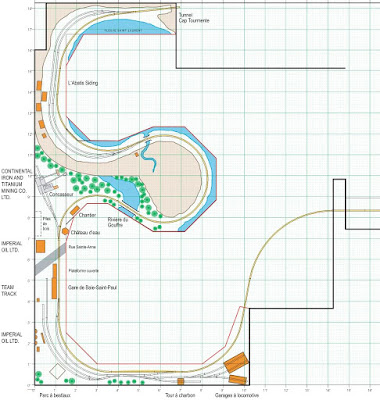The theme will be rural countryside with a small passenger station to run some commuter and excursion trains. A few sidings will also be made as an scenicked fiddle yard were we will built trains scheduled to Hedley.
Murray Bay Subdivision History
We often had talks about doing the Murray Bay Subdivision instead of Montmorency Division. This subdivision is famous for its breath-taking landscapes and its tormented main line built between the St. Lawrence River and the mountains.
After watching pictures from the subdivision and insurance maps, I decided to make a proposition.
The Proposed Expansion
 |
| The new Murray Bay Subdivision |
Starting from Hedley-Junction, the main line exit the furnace closet as the Cap-Tourmente Tunnel, a famous but inaccessible spot on the line. From this point, the track runs beside the river and the train reach the first "station" known as L'Abatis Siding, a typical passing track with some storage capacity (fiddling yard). To make it more interesting, I decided to merge visually L'Abatis and Sault-au-Cochon - another passing track - to get the right feeling. Also, the fiddling yard is located in such a manner that an operator located in Hedley can see his train from there. It will operation easier. The original fiddling yard was located right after the tunnel and was hidden by the furnace closet. We constantly had to have somebody at the other side of the tunnel to make sure the train was in the correct location.
Exiting L'Abatis Siding, the train curves around Sault-au-Cochon, a majestuous cape made infamous after the tragic plane crash that occured there back in the fifties. It was recorded in history as the first civilian flight to crash under criminal motives in History. Le crime d'Ovide Plouffe (Ovide Plouffe's Crime), a French-Canadian movie from the 1980's, was inspired by this tragedy. In many places in Charlevoix, you can see the mainline doing s-curves around mountains and cape in this fashion. For once, it is prototypical.
Then, the track leaves the St. Lawrence shores and enter the fertiles lands from the Du Gouffre River which is crossed by a steel bridge. In reality, the change in topography is also drastic because Baie-Saint-Paul is built in the lower part of a crater. A few hundred millions years ago, a large meteor landed in this mountainous area and flattened a circular valley which hosts fertile soils and an important ilmenite ore mine (titanium and iron) which was exploited since the late-1800's. Back then, a wooden railway was built between Baie-Saint-Paul and Saint-Urbain. It lasted from 1872 to 1874, however, the mine return in exploitation back in the early 20th century. Around 1957's, Continental Iron and Titanium Mining Co. Ltd. was running a rail-served stone crusher located east to Baie-Saint-Paul station. The raw ore was shipped by train to Quebec City to be refined in some steel mill. The ore was probably loaded on ships in Quebec City Harbour.
Baie-Saint-Paul was one of the most important station on Murray Bay Subdivision, including La Malbaie (Murray Bay) and Clermont. Steam engine facilities were built back in 1919. A coal tower, an enclosed water tower, many section houses and freight sheds were located on each side of the station. As far as the 1920's, Imperial Oil Ltd. operated an oil terminal near the team track. Lumbers and pulpwood were also loaded on trains. On the proposed layout, the area depicted from the bridge to the Imperial Oil Loading Dock is almost prototypical and full-sized. However, the engine facilities was done according to La Malbaie engine house minus the turntable. I was also working from reminescences of an old picture depicting the facilities back in 1919. However, I'm unable to locate anymore this interesting picture.
After Baie-Saint-Paul, a removable section of track joins the new layout to Lairet Station through a new hole in the wall. Since this section can be bothersome depending the circumstances, the layout is designed so it can be operated as a point-to-point layout when it is not in place.
No comments:
Post a Comment